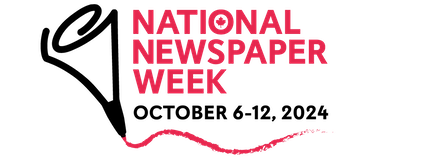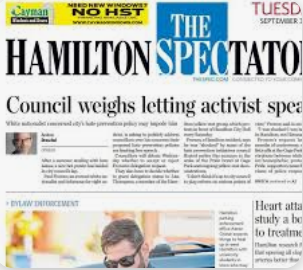 |
|
|
On page 75 of Journalism for The Public Good, The Michener Awards at 50, author Kim S. Kierans writes me — yes, me — into the men’s room of the governor general’s residence in Ottawa, in conversation with the famous Canadian journalist/author/ editor and one-time master of Massey College, John Fraser.
 |
|
|
Because it’s National Newspaper Week and you must read Kierans’ new book.
Anyway, I started The Marrow Thieves because Cherie was the author but finished it because the story was so gripping. (The Marrow Thieves then went on to become a best-selling award winner. Feels great when that happens.) I started Journalism for the Public Good because my name was in it then finished the book because it was so damn interesting and easy to read.
Here’s him on CITIZN: “Look, the idea of UBER for journalism is as broad as the concept itself.
“The possible combinations are limitless, but it means that every journalist now has a global potential audience rather than a local audience in their field of expertise. Say you are an expert in Northern Ontario [nice, Murray, thanks]; loads of people around the world would want to call on you, likely daily.”
About the Author: Peter Carter
 |
|
|
Toronto writer/ editor/ one-time magazine owner and publisher---35 years experience in Canadian magazines; currently Analysis Editor at Law360 Canada; an online daily news source for Canadian lawyers; Winner of Best Business Blog at COPAs 2014 for Pete's Blog&Grille; National Magazine Awards finalist; accordion player and motorbike enthusiast.
 |
|
|
Pepper Parr, Publisher of the Burlington Gazette is writing a series of articles on the state of the industry. Pepper has been a judge of the COPAs and this series is also on the site at this link. This is the second of a series on the changes taking place in print media and the challenge keeping the public informed.
In the period leading up to 2000 media found itself facing realty difficult times. When Y2k (remember that event) was upon us no one really knew what was going to happen when we moved into the new millennium.
 |
|
Newspapers were selling their printing presses and contracting the work out.
|
Media covered the event like a wet blanket – there were those that said it wasn’t really a problem while others suggested the machines that drive production would come to an immediate halt.
Media did a lot of reporting – but they didn’t pause to ask: what does this mean to us as an industry?
I don’t recall reading about any industry wide workshops; I don’t recall seeing anything in the way of op-ed pieces on what the industry needed to do in the way of changes.
Media covered disruption – without realizing that they were in line for some major disruption to their industry and they weren’t prepared.
The industry no longer had the aura of Watergate or the Pentagon Papers that made reporters heros – at that time thousands flooded into the industry wanting to be reporters. Reporters Bob Woodward and Carl Bernstein were the subject of close to fawning news stories, television specials and movies.
By the late 1980s journalism schools were being closed. The number of students that graduated got smaller and smaller.
The age of the men and woman in the news rooms was made up of people in their late 40’s and 50’s – there was no new blood coming into the industry. And there were few MBAs on staff of the large newspapers.
Those that were public corporations had financial analysts looking at profits which were decent at the time – what those analysts didn’t see was that the boat was moving quickly toward a Niagara size waterfall.
When the disruption of the revenue sources began media didn’t have a Plan B – they watched is losses began to climb and subscriptions slowly slipped away.
 |
|
|
The data relates to American newspaper – the number will not be much different for Canada.
 |
|
|
As Publisher of the Burlington Gazette I am driven by this statement. “Informed people can make informed decisions.” Media is the only sector that can deliver the information. The politicians don’t – they issue statements that project the story they want to tell. I have been a journalist from the day my first picture and story appeared on the front page of the Montreal Gazette. I have published books, magazines and newspapers. I was the founding editor of the Toronto Ward 9 News in about 1972. The Burlington Gazette started publishing as an on-line newspaper in 2010.
This story was originally posted in the Burlington Gazette on October 8, 2024 at this link
 |
|
|
Pepper Parr, Publisher of the Burlington Gazette is writing a series of articles on the state of the industry. Pepper has been a judge of the COPAs and this series is also on the site at this link.
 |
|
Once the largest newspaper in western GTA – the Spectator struggles to stay alive.
|
Craig’s List and Kijiji killed Classified Advertising
 |
|
Classified advertising was phenomenally successful
|
 |
|
Soon after Kijiji was created others created versions of online advertising that included photographs – it was classified with colour and all on line.
|
 |
|
Going totally digital worked for Montreal’s French language newspaper.
|
It worked for LaPresse – the Star was never able to convince their readers that online was going to be the way you got your news. In 2016, a few years after the launch of La Presse+, print was restricted to Saturdays and shortly thereafter, on 31 December 2017, the last newspaper was printed.
 |
|
Nicole MacIntyre – Toronto Star editor
|
 |
|
|
As Publisher of the Burlington Gazette I am driven by this statement. “Informed people can make informed decisions.” Media is the only sector that can deliver the information. The politicians don’t – they issue statements that project the story they want to tell. I have been a journalist from the day my first picture and story appeared on the front page of the Montreal Gazette. I have published books, magazines and newspapers. I was the founding editor of the Toronto Ward 9 News in about 1972. The Burlington Gazette started publishing as an on-line newspaper in 2010.
This story was originally posted in the Burlington Gazette on October 7, 2024 at this link
 |
|
|

.jpg)

